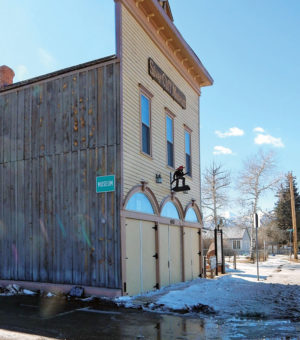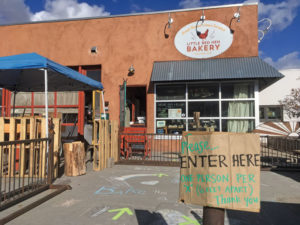By Forrest Whitman
All eyes are on the COVID-19 pandemic. But, a story that’s been shoved aside might just be nearly as important long term. A railroad war is going on right now between the Rio Grande Pacific R.R. and the Colorado and Pacific R.R. It’s over the old main line of the Denver and Rio Grande Western R.R. which follows the river right through the valley. Who wins that battle will determine a lot of things for the upper Arkansas River Valley.
Our whole transportation picture and land use could change once those rails come alive. They surely will live again if Stefan Soloviev and his Colorado and Pacific Railroad wins. The opposition to Soloviev is a little-known group out of Utah called the Rio Grande and Pacific. The Union Pacific, the current owner, apparently has resisted every offer since they put the line out of service in 1979.
The Colorado and Pacific is under the gun in this deal. The farms and ranches of eastern Colorado have delivered their agricultural wealth under stress for the last two decades. Low prices and high transportation bills have been crippling. This is of wider import. The nation will need all of that agricultural wealth as we recover from the current pandemic.
There will be some assistance for the agricultural sector in the new federal stimulus bills. Colorado and Pacific is designed to be an agriculture transporter so money could flow that way. That stimulus money won’t extend to some individual ag workers in that field (no pun intended). Still, nothing could help as much as being able to ship by rail as opposed to truck. Rail is set up to ship heavy loads of agriculture products and mining supplies (think Climax mine), slowly but cheaply.
Stefan Soloviev, mastermind of the C & P, owns vast tracts of agricultural land in eastern Colorado and western Kansas. The problem he and others face is how to ship that wealth reasonably. They still feel the blow that came when the Missouri Pacific sold the Towner R. R. line to a holding company. Those owners had no interest in serving the grain elevators along their route nor shipping any mining supplies. They planned to scrap it.
Soloviev’s group, ever resourceful, simply bought the Towner railroad. Soloviev, being worth several billion bucks, has the deep pockets to do things like that. The Towner line, now the Colorado and Pacific R.R., applied for a forced sale before the Surface Transportation Board. Soloviev argued for the line as vital to the nation’s commerce. He won. Today it runs the route at 25 M.P.H. to Pueblo (after putting in $3.5 million in upgrades).
But getting to Pueblo was not enough. Soloviev offered to buy the Union Pacific’s line through the Royal Gorge, over Tennessee Pass and on down the Vail Valley for $20 million. This would enable him to ship agricultural goods and mining supplies directly to the West Coast (via Salt Lake with its agriculture milling capacity). Why the U. P. wouldn’t sell is a bit of Upper Ark history.
History tends to rhyme. In the 1870s a similar railroad war was waged between the Rio Grande Railroad and the Santa Fe Railroad. That “great railroad war” went on for years and finally ended up in the Supreme Court. An out of court settlement “The Treaty of Boston” at last ended it. In that agreement the Rio Grande Railroad got rights to go to rich Leadville. But Mr. Palmer’s Rio Grande was thwarted in his attempts to build south to the Rio Grande River and on to Mexico.
Today the rail line they fought over is the old main line of the Denver Rio Grande and Western. Its 228-mile route stretches from Pueblo, over Tennessee Pass, and on to Minturn and Dotsero where it joins the class one rails.
Tennessee Pass was tough for the Denver and Rio Grande. There are some steep stretches on the pass including some 3% grades. Trains had to have helper units stationed in Minturn. That was both to get up the Tennessee pass grade, but also to brake on the down grade. It wouldn’t be easy for the C&P to run it today. Soloviev’s latest offer of around $8 million is not all that low ball.
1988 was a fateful year for the line. The Southern Pacific R.R. bought the Denver and Rio Grande that year (actually a swallowing merger). Soon the line was a major east-west route. At least a dozen trains a day powered up the pass. Minturn and Salida were busy railroad towns again.
That all changed in 1996 when another route consolidation took place. Now the Union Pacific was the owner. They favored the Moffat Tunnel route for east-west traffic. Even though the Moffat Tunnel was often at capacity, the UP abandoned the local line. It has been moldering away since 1997. The U.P. has simply shown no interest in selling it.
Soloviev’s next move was to petition the surface transportation board to force the U.P. R.R. to sell him the Tennessee Pass Line, our local railroad. Then he could ship to Pueblo where the Towner line ends and over the mountains directly to Salt Lake City and the west coast ports.
Just as in the historic railroad war, this fight ended up with a winner in the first skirmish, but not a clear winner. The Union Pacific argued before the Surface Transportation Board that they might have another prospective buyer. That’s always credibly rumored to be the Rio Grande and Pacific R.R. That group has long argued for building an 80-mile-long line from the U.P. main line in Wyoming down to the shale oil fields of northeast Utah.
That particular theory has never worked well. The oil is kerogyn and locked in the shale. It needs to be cooked out and then put under pressure in tank cars to move. The price of oil would have to be astronomically high for any profit to be made in that complex scheme.
All small towns along the Tennessee Pass route ought to be fearful of the Utah plan. That includes towns in the Upper Ark. Crude oil in tank cars has a tendency to explode. In fact, one village in Canada was wiped out when just that happened. Accidents like that do happen. Canada has put a 25 M.P.H. speed limit on all crude oil trains after citing numerous explosions.
Soloveiv was not so lucky before the surface transportation board this time. No forced sale. We’ll see what his next move is. Why the U.P. won’t sell has never been clear. Obviously the U.P. wants no east -west competition but their route through the Moffat tunnel is often clogged. The danger from crude oil cars in the tunnel would be horrendous.
Also, the reported offer from the Utah group is hazy indeed. Soloviev is tenacious on his side. On the other hand, several Utah counties back the oil play by the Rio Grande Western, even though no dollar figure has emerged. It’s a war wreathed in engine smoke.
One thing is clear, a rail war in the Upper Ark is on again in 2020. It seems almost a replay of the 1879 battle over this same right of way between the Santa Fe R. R. and the Rio Grande R. R. That ended with the treaty of Boston. Maybe this will end with a treaty too.
The Upper Ark Valley has a lot to gain or lose. The kind of traffic that moves through downtown Salida, Buena Vista, Cañon City and Cotopaxi makes a difference, maybe even a crucial difference. The Coronavirus war will end, but those rails will still be busy after this new railroad war is over.
Forrest Whitman hosts a radio show at KHEN.org, “On the Rails.”



